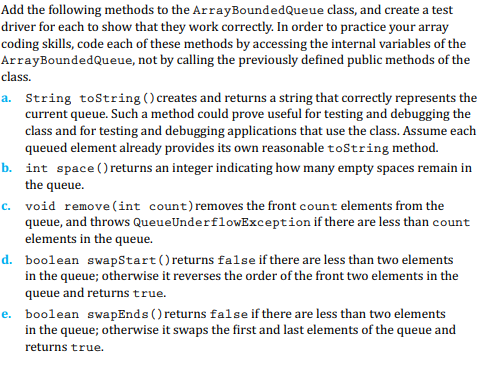Question
public class ArrayBoundedQueue implements QueueInterface { protected final int DEFCAP = 100; // default capacity protected T[] elements; // array that holds queue elements protected

public class ArrayBoundedQueue
public ArrayBoundedQueue() { elements = (T[]) new Object[DEFCAP]; rear = DEFCAP - 1; }
public ArrayBoundedQueue(int maxSize) { elements = (T[]) new Object[maxSize]; rear = maxSize - 1; }
public void enqueue(T element) // Throws QueueOverflowException if this queue is full; // otherwise, adds element to the rear of this queue. { if (isFull()) throw new QueueOverflowException("Enqueue attempted on a full queue."); else { rear = (rear + 1) % elements.length; elements[rear] = element; numElements = numElements + 1; } }
public T dequeue() // Throws QueueUnderflowException if this queue is empty; // otherwise, removes front element from this queue and returns it. { if (isEmpty()) throw new QueueUnderflowException("Dequeue attempted on empty queue."); else { T toReturn = elements[front]; elements[front] = null; front = (front + 1) % elements.length; numElements = numElements - 1; return toReturn; } }
public boolean isEmpty() // Returns true if this queue is empty; otherwise, returns false. { return (numElements == 0); }
public boolean isFull() // Returns true if this queue is full; otherwise, returns false. { return (numElements == elements.length); } public int size() // Returns the number of elements in this queue. { return numElements; } }
Add the following methods to the ArrayBoundedQueue class, and create a test driver for each to show that they work correctly. In order to practice your array coding skills, code each of these methods by accessing the internal variables of the ArrayBoundedQueue, not by calling the previously defined public methods of the class. a. String toString () creates and returns a string that correctly represents the current queue. Such a method could prove useful for testing and debugging the class and for testing and debugging applications that use the class. Assume each queued element already provides its own reasonable tostring method. b. int space () returns an integer indicating how many empty spaces remain in the queue. c. void remove(int count) removes the front count elements from the queue, and throws QueueUnderflowException if there are less than count elements in the queue. d. boolean swapStart() returns false if there are less than two elements in the queue; otherwise it reverses the order of the front two elements in the queue and returns true. e. boolean swapEnds() returns false if there are less than two elements in the queue; otherwise it swaps the first and last elements of the queue and returns true
Step by Step Solution
There are 3 Steps involved in it
Step: 1

Get Instant Access to Expert-Tailored Solutions
See step-by-step solutions with expert insights and AI powered tools for academic success
Step: 2

Step: 3

Ace Your Homework with AI
Get the answers you need in no time with our AI-driven, step-by-step assistance
Get Started


